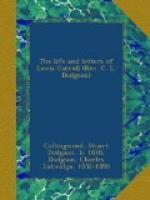This church, which is dedicated to St. Peter, is a quaint old building with a Norman porch, the rest of it being of more modern construction. It contains a raised pew, which is approached by a winding flight of stairs, and is covered in, so that it resembles nothing so much as a four-post bedstead. This pew used to belong to the Milbanke family, with which Lord Byron was connected. Mr. Dodgson found the chancel-roof in so bad a state of repair that he was obliged to take it down, and replace it by an entirely new one. The only village school that existed when he came to the place was a sort of barn, which stood in a corner of the churchyard. During his incumbency a fine school-house was erected. Several members of his family used regularly to help in teaching the children, and excellent reports were obtained.
The Rectory is close to the church, and stands in the middle of a beautiful garden. The former incumbent had been an enthusiastic horticulturist, and the walls of the kitchen garden were covered with luxuriant fruit-trees, while the greenhouses were well stocked with rare and beautiful exotics. Among these was a specimen of that fantastic cactus, the night-blowing Cereus, whose flowers, after an existence of but a few hours, fade with the waning sun. On the day when this occurred large numbers of people used to obtain Mr. Dodgson’s leave to see the curiosity.
[Illustration: Croft Rectory]
Near the Rectory is a fine hotel, built when Croft was an important posting-station for the coaches between London and Edinburgh, but in Mr. Dodgson’s time chiefly used by gentlemen who stayed there during the hunting season. The village is renowned for its baths and medicinal waters. The parish of Croft includes the outlying hamlets of Halnaby, Dalton, and Stapleton, so that the Rector’s position is by no means a sinecure. Within the village is Croft Hall, the old seat of the Chaytors; but during Mr. Dodgson’s incumbency the then Sir William Chaytor built and lived at Clervaux Castle, calling it by an old family name.
Shortly after accepting the living of Croft, Mr. Dodgson was appointed examining chaplain to the Bishop of Ripon; subsequently he was made Archdeacon of Richmond and one of the Canons of Ripon Cathedral.
Charles was at this time very fond of inventing games for the amusement of his brothers and sisters; he constructed a rude train out of a wheelbarrow, a barrel and a small truck, which used to convey passengers from one “station” in the Rectory garden to another. At each of these stations there was a refreshment-room, and the passengers had to purchase tickets from him before they could enjoy their ride. The boy was also a clever conjuror, and, arrayed in a brown wig and a long white robe, used to cause no little wonder to his audience by his sleight-of-hand. With the assistance of various members of the family and the village carpenter, he made a troupe of marionettes




